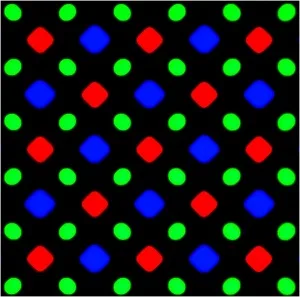It takes a long time to develop novel display technologies. As a result, product designers sometimes express a desire for display characteristics that the industry cannot supply – at least not yet, and maybe never.

It can work the other way, though. Candice Brown Elliott’s brilliant Pentile Display architecture was initially developed to improve efficiency, effective pixel density and battery life in laptop PCs using LCDs. Instead, the industry found ways to use a brute force approach and create LCDs with more and more physical pixels, along with sufficient energy savings from improved backlights and energy savings. Pentile waited for years to find its killer app: allowing Samsung to make larger OLED subpixels for a given pixel format, thus reducing current density and improving lifetime.
Sometimes, the app never comes and what once seemed a golden window of opportunity slams shut, never to re-open. That is more or less what happened to field-emission displays (FEDs). When development work began in earnest, the color gamut, brightness, power efficiency and viewing angle of LCDs for laptops PCs was – how can I say this politely – “sub-optimal”. There was a real problem and reasonable people convinced themselves that FEDs could be the solution.
But FEDs simultaneously required vacuum, high voltage and a rather complicated internal structure both to provide the electronic-emitting tips and to support the glass substrates against atmospheric pressure. Molecules stripped from interior surfaces compromised the vacuum, and charges on the supporting walls produced display artifacts.
Around 2000, Candescent Technologies was showing decent-looking prototypes at the SID show, each of which was displayed on a table with a skirt hanging down to the floor. There were persistent rumors that behind each skirt was a large container of getter attached to the prototype FED with a tube to continually remove the contaminants from the evacuated interior of the display. Whether these rumors were true or not, Candescent gave up manufacturing plans by the end of 2001. Even if FED’s problems could eventually be solved, performance of LCDs for laptops had already improved to the point that FED’s window of opportunity had closed. Subsequent efforts by Sony to apply the technology to television seemed to solve the technical problems but could not make the cost competitive. And by that time, OLED was promising to do everything FED could do without vacuum and without high voltage.
What new technology might product designers be waiting for today? A reflective display with good color in phone or tablet sizes would probably find takers. E Ink’s color electrophoretic display has a specialized niche, but since it uses a matric color filter in front of a black-and-white reflective imaging film, it produces images that are rather dark and have a limited color gamut. At one time, E Ink was working on a version that used red, green and blue reflective particles for a filterless display, but I haven’t heard anything about that recently (which may mean that it’s proceeding very well or not proceeding at all).
Qualcomm’s reflective Mirasol technology never produced sufficiently good color for tablets or phones, but has recently established a niche in smartwatches, where wide color gamut and color fidelity are less important that low power and sunlight visibility.
Finally, little has been heard from Liquavista since it was purchased by Amazon about two years ago. But the creative Liquavista team is still laboring away somewhere in the dungeons of Castle Amazon. Will they emerge someday with a Kindle Liquid eReader? Time will tell.
There are other novel display technologies we could talk about, including Sharp’s “free-form” displays with gate drivers at each pixel site and the Pixtronix in-plane MEMS technology with IGZO backplane, also being made by Sharp.
But finally, at least as far as this column is concerned, the one new technology that could really change things in the future is micro-LEDs. Apple and its recently acquired LuxVue are not the only players, and I suspect there will be lot to talk about in the coming year and almost certainly some developments at the up-coming SID Display Week Although the obvious short-term application is smartwatches, developers are thinking about larger applications. They’re thinking hard. – Ken Werner
![]() This version of the Pentile pixel architecture is used in Samsung’s Note 3 phablet. The original architecture developed by Clairvoyant used a blue subpixel that was much larger than the red and green. In early discussions with Samsung, Samsung engineers observed that such a pattern demanded zig-zag bus lines that would increase parasitic capacitance. Subsequent generations used rectangular pixel patterns, but Samsung has made much of the “diamond pixels” in recent generations of its Pentile displays. Many popular descriptions of Pentile displays don’t make sense because the writers fail to appreciate the essential role of two-dimensional sub-pixel rendering in the operation of these displays.
This version of the Pentile pixel architecture is used in Samsung’s Note 3 phablet. The original architecture developed by Clairvoyant used a blue subpixel that was much larger than the red and green. In early discussions with Samsung, Samsung engineers observed that such a pattern demanded zig-zag bus lines that would increase parasitic capacitance. Subsequent generations used rectangular pixel patterns, but Samsung has made much of the “diamond pixels” in recent generations of its Pentile displays. Many popular descriptions of Pentile displays don’t make sense because the writers fail to appreciate the essential role of two-dimensional sub-pixel rendering in the operation of these displays.

